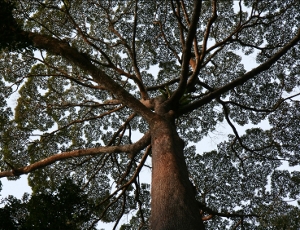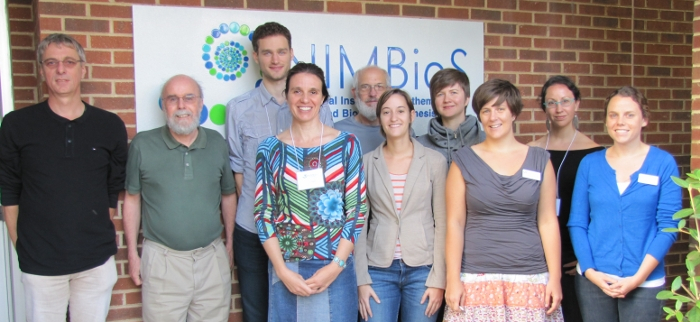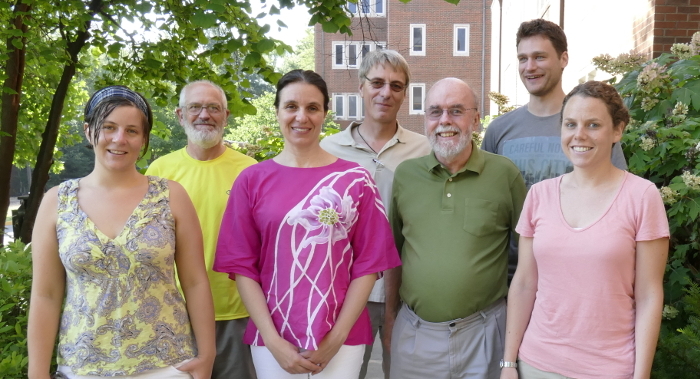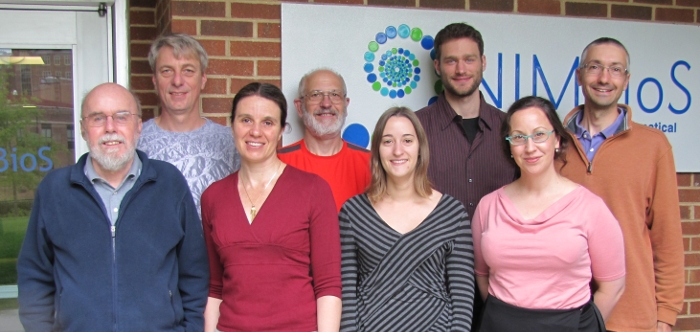| Description | Participants | Summaries | Products |
|---|

Archived NIMBioS Working Group
A DEB Model for Trees
Topic: A mechanistic dynamic energy budget model of tree performance to predict functional trait drivers, species distributions, and responses to global change
Meeting dates: October 14-17, 2014; June 15-19, 2015; May 16-20, 2016
Organizers:
Glenn Ledder, Mathematics, Univ. of Nebraska, Lincoln
Sabrina E. Russo, Biological Sciences, Univ. of Nebraska, Lincoln
Roger M. Nisbet, Ecology, Evolution, and Marine Biology, Univ. of California, Santa Barbara
Objectives: By working at the interface of state-of-the art mathematical process modeling and tree biology, this working group plans to develop a mechanistic dynamic energy budget model to predict the growth and survival of individual tropical trees. The model will simulate plant growth and survival based on measured functional trait values and responses to environmental variation, including irradiance, soil moisture and nutrients, and temperature. Our model will identify combinations of functional and biomass- and nutrient-allocation traits that maximize net photosynthetic carbon gain (C-gain) and survival at the level of the whole tree. We will test this model by comparing predicted trends in functional traits, growth, and survival along resource availability gradients with data for Bornean and Bolivian tree species. The model will enable prediction of (1) species distributions based on differences in performance of trees in response to variation in resources, such as along natural environmental gradients and (2) responses of trees to environmental shifts caused by global change. This model capability and the combined expertise that will enable its development are unprecedented, and should attract wide interest and application in forest ecosystems worldwide.

Meeting Summaries
| Mtg # | Dates | Agenda | Summary | Photo | Evaluation |
|---|---|---|---|---|---|
| 1 | Oct 14-17, 2014 | Link | Link | Report | |
| 2 | Jun 15-19, 2015 | Link | Link | ||
| 3 | May 16-20, 2016 | Link | Link |
Meeting 1 Summary. Global anthropogenic changes are placing enormous pressures on plants and animals, yet how species will respond to climate changes is still very uncertain. Globally, trees, especially tropical forests, represent close to 90% of biomass carbon and take up about 30% of atmospheric CO2 emissions, and so trees are critical to mitigating increasing atmospheric CO2. One of the greatest unknowns is the complexity of the physiological responses of trees as there are no comprehensive mechanistic models to predict how physiological functions are integrated within a tree to influence its growth and survival. The principle effort at the DEB Model for Trees Working Group meeting was directed toward building a complete mechanistic whole-tree dynamic energy budget model that will enable powerful predictions of tree species' responses to climate change and transform our understanding of functional integration and trade-offs in trees. This required a significant redesign of the Dynamic Energy Budget (DEB) superstructure of the model, resulting in a hierarchical framework with the primary division between above-ground and below-ground components and a secondary division according to the functions of resource acquisition and transport. We also worked on submodels for uptake of water and nutrients by roots and the consequent depletion of these resources, and we discussed current theories about the direct causes of tree mortality and how to include these mechanisms in the model. A secondary focus of the meeting was the identification and discussion of a variety of questions that the model could be used to address and discussed the trade-offs in function that would need to be incorporated into the model to address those questions.
Meeting 2 Summary. Work done subsequent to the first meeting has yielded publishable results that will be the core of a paper that models obligate syntrophy in general, with trees as one particular example. Additional work resulted in a full description of the DEB superstructure that we anticipate using for subsequent models. Work at the second meeting focused in part on refining the obligate syntrophy investigation and outlining a manuscript on it that we expect to submit for publication in early 2016. Additional work at the meeting focused on detailed modeling of the tree physiology submodel that will be determine the rates of resource production needed in the DEB model as well as the effect of root uptake on the resource availability in the soil. A secondary focus of the meeting was the identification and discussion of important questions to be addressed by specific submodels. These include the question of how to use information about a tree's current state to estimate survival probability for given environmental conditions and the question of whether the standard practice of computing averages for the hydraulic properties of tree organs is adequate.
Meeting 3 Summary. Global anthropogenic changes are placing enormous pressures on plants and animals, yet how species will respond to climate changes is still very uncertain. Globally, trees, especially tropical forests, represent close to 90% of biomass carbon and take up about 30% of atmospheric CO2 emissions, and so are critical to mitigating increasing atmospheric CO2. One of the greatest unknowns is the complexity of the physiological responses of trees, since there are no comprehensive mechanistic models to predict how physiological functions are integrated within a tree to influence its growth and survival. Developing such a model is the focus of the DEB Model for Trees working group. In work prior to our third meeting, the group sketched out an investigation using an obligate syntrophy model as a way to model allocation to roots versus shoots, developed a dynamic energy budget superstructure to model storage dynamics, and continued developing the detailed mathematical components of an integrated physiology and environment model and producing computer code for it. Work at the third meeting followed four primary directions: (1) further refining the details of the obligate syntrophy paper in preparation for manuscript publication, (2) working out details in the physiology model, (3) outlining investigations that will use these models to better understand how plants respond to drought, (4) working out the integration of the dynamic energy budget superstructure with the physiology component. Additional work was done to develop a modified syntrophy model that includes water as a resource.
 |
| Meeting 1 participants (L to R): Erik Muller, Roger Nisbet, Valentin Couvreur, Sabrina Russo, Glenn Ledder, Megan Bartlett, Elke Zimmer, Angie Peace, Danielle Way, Caroline Farrior. (Not pictured): Lawren Sack, Lourens Poorter, Frank Sterck. |
 |
| Meeting 2 participants (L to R): Angie Peace, Glenn Ledder, Sabrina Russo, Erik Muller, Roger Nisbet, Valentin Couvreur, Caroline Farrior. Not pictured, Danielle Way. |
 |
| Meeting 3 participants (L to R): Roger Nisbet, Erik Muller, Sabrina Russo, Glenn Ledder, Megan Bartlett, Valentin Couvreur, Danielle Way, Stefano Manzoni. |
NIMBioS Working Groups are chosen to focus on major scientific questions at the interface between biology and mathematics. NIMBioS is particularly interested in questions that integrate diverse fields, require synthesis at multiple scales, and/or make use of or require development of new mathematical/computational approaches. NIMBioS Working Groups are relatively small (up to 10 participants), focus on a well-defined topic, and have well-defined goals and metrics of success. Working Groups will meet up to 3 times over a two-year period, with each meeting lasting up to 2.5 days.
A goal of NIMBioS is to enhance the cadre of researchers capable of interdisciplinary efforts across mathematics and biology. As part of this goal, NIMBioS is committed to promoting diversity in all its activities. Diversity is considered in all its aspects, social and scientific, including gender, ethnicity, scientific field, career stage, geography and type of home institution. Questions regarding diversity issues should be directed to diversity@nimbios.org. You can read more about our Diversity Plan on our NIMBioS Policies web page. The NIMBioS building is fully handicapped accessible.
NIMBioS
1122 Volunteer Blvd., Suite 106
University of Tennessee
Knoxville,
TN 37996-3410
PH: (865) 974-9334
FAX: (865) 974-9461
Contact NIMBioS


